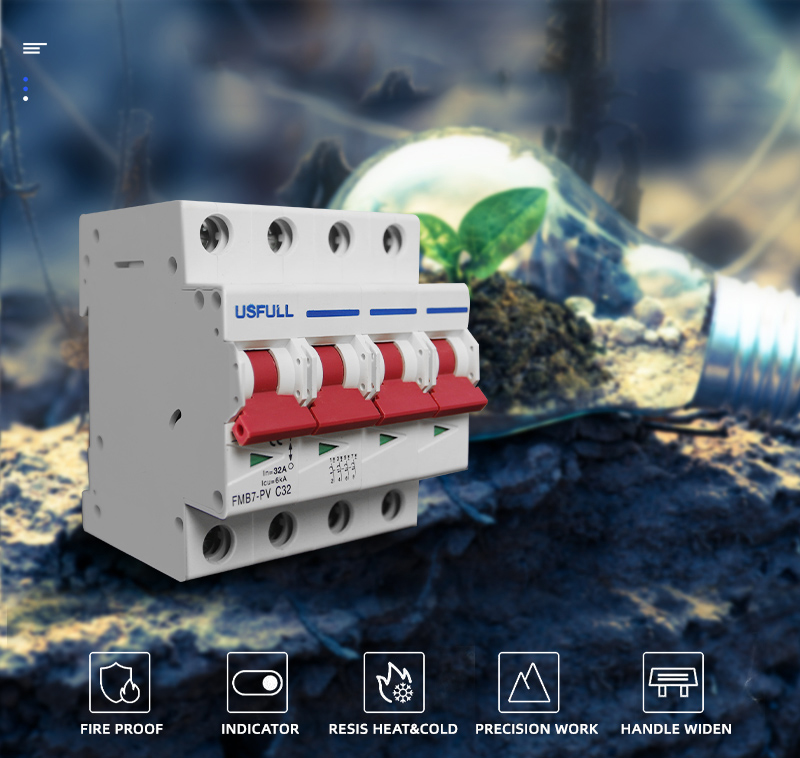How can we use DC Breakers? When a DC circuit is about to overload, a circuit breaker immediately cuts the power to that circuit. This protects the power supply and any appliances plugged into it.
If there is a problem with the electricity, the breaker will shut off the power immediately. Circuit breakers can be reset after overloading, but fuses blow when they get too hot. The power is turned off before the fuse blows because of the circuit breaker.
The goal of this research is to give a technical explanation of the most common ways that circuit breakers are used with direct current. The main goal is to give accurate information through tables to help people choose protection quickly, with a focus on installation characteristics (fault typologies, installation voltage, earthing arrangement).
What is the Function of a DC Circuit Breaker?
DC circuit breakers follow the same safety rules when it comes to heat and magnetism as their AC counterparts:
Thermal protection trips the breaker when the DC current goes over a certain level. When the bimetallic contact gets hot, it swells up. This causes the circuit breaker to trip. When the current is high, more heat is made, which causes the insulation to grow and break the connection between the wires more quickly. The heat protection on a DC circuit breaker is meant to trip at a current level higher than the normal operating current.
When there are big fault currents, magnetic protection trips the DC circuit breaker, and it always does this right away. DC circuit breakers have a rated breaking capacity that shows the maximum fault current that can be stopped. This is the same as AC circuit breakers. Because DC circuit breakers are meant to stop a constant current, the electric contact must be opened further to stop the fault current. The magnetic protection of a DC circuit breaker prevents damage from short circuits and other problems that are much worse than an overload.
What is the DC miniature circuit breaker (MCB)?
MCBs for both alternating current and direct current do the same things. They keep the electrical circuit’s integrity and the load equipment safe from overload and short-circuit risks. The AC MCB and the DC MCB are moulded case circuit breakers, but they are used differently. It is mostly affected by whether the voltage is applied as a direct or alternating current. Direct current technologies like solar PV, renewable energy, and so on are often used in DC MCBs. DC MCBs can handle voltages between 12 volts and 1000 volts.
USFULL’s DC breakers can handle high voltage and rough environments because their shells can’t catch fire. Most solar installations will be in places that aren’t well-developed, like deserts, and we can give you products that will work well even in these places.
Three Types of Miniature Circuit Breakers:
- A Type B circuit breaker (trips at 3-5 times rated current).
- Type C (trips at 5-10 times rated current).
- Type D (trips at 10-20 times rated current).
The protection settings can be changed on circuit breakers with a molded case, and the breakers are often bigger.
How do you hook up a DC MCB the right way?
Because DC MCBs only have a plus sign (+) and a minus sign (-), people often need to correct them. If a DC small circuit breaker is not connected or wired well, it could cause problems. If an MCB is overloaded or has a short circuit and can’t stop the flow of electricity and put out the arc, it could be damaged or destroyed. So, DC MCBs are marked with the “+” and “-” symbols, and the direction of the circuit and wiring diagrams must still be shown.
Some DC breakers can reset themselves, but the vast majority need to be reset by a person. By flipping the switch, you can get back to normal operation. On the other hand, a computer needs a person to restart it, so it can’t be done automatically. But once the circuit breaker is reset, the lights and appliances connected to the overloaded circuit will normally work again.
The USFULL DC breaker has a modulus width of only 3.5 mm and is available in current ratings from 6A to 63A, which makes it perfect for DIN-rail installation. They are small and easy to set up, so you can use them in a PV combiner box, on a wall, or anywhere else.
You can remember which end is positive and which is negative. You don’t have to worry about whether you’re connecting to P+ or P- since either will function.


